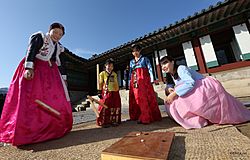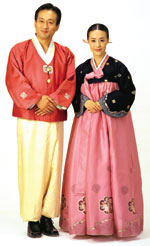Korean New Year facts for kids
Quick facts for kids Seollal |
|
|---|---|

|
|
| Also called | Seollal |
| Observed by | Korean people around the world |
| Type | Cultural |
| Significance | First day of the Chinese lunar calendar |
| Date | Typically the second new moon after the winter solstice |
| Frequency | Annual |
| Related to |
|
| Korean New Year | |
| Hangul |
설날
|
|---|---|
| Revised Romanization | Seollal |
| McCune–Reischauer | Sŏllal |
Seollal (Korean: 설날; RR: Seollal; MR: Sŏllal) is a very important holiday in Korea. It celebrates the first day of the Korean calendar. This holiday is one of the most traditional and special times in both North and South Korea.
The celebration usually lasts for three days. These days are the day before New Year, New Year's Day itself, and the day after New Year. During this time, many Koreans visit their families. They also perform special ceremonies to honor their ancestors. People often wear beautiful traditional clothes called hanbok. They eat delicious Korean food and play fun folk games. A favorite part for children is often receiving money, called Sebaetdon, from their elders. This happens after they perform a special bow.
Seollal usually happens in January or February. It is based on the second new moon after the winter solstice.
Contents
What is Seollal?
'Seollal' usually means the Lunar New Year. This is the traditional Korean New Year. There is also a "Solar New Year," which is January 1st, like in many other countries. But the Lunar New Year, Seollal, is the main traditional celebration.
How Seollal Began
The idea of Korean New Year celebrations is very old. Some old Chinese history books from the 3rd century mention similar celebrations. These events included singing and dancing in a place called Buyeo.
Later records from the 7th century also talk about New Year's Day celebrations. These happened in the Silla Kingdom in Korea. Korea's own history books from the 13th century also describe these celebrations. They show that New Year was celebrated in Silla as early as 488 AD. The celebration of Korean New Year has continued through many Korean kingdoms.
For a time, celebrating Seollal was not allowed. This happened when Japan took control of Korea. The Japanese rulers wanted Koreans to celebrate the New Year on January 1st, like in Japan. But after Korea became free in 1945, the government made January 1st to 3rd a public holiday.
In the 1980s, many Koreans wanted to bring back their traditional New Year. So, in 1989, the government made the traditional Lunar New Year an official national holiday again.
Seollal Family Customs
The Korean New Year is a very important family holiday. Many people use the three-day holiday to travel back to their hometowns. They visit their parents and other relatives. There, they perform a special ancestral ritual called charye. This ritual honors their family members who have passed away.
Millions of Koreans travel during this time, both within Korea and from other countries. It is a time when families can gather and catch up. Because of this, it is considered very important to attend the holiday. People often visit their grandparents and parents first. It is also polite to visit their in-laws.
Preparing for Seollal can be expensive. Families often give gifts to each other. People also wear new clothes for the holiday. Many traditional foods are made for the family gathering. Because so many people buy food for the holiday, prices can go up. To help, the government sometimes takes steps to keep food prices stable.
Honoring Ancestors
On the first morning of Seollal, Koreans show respect to their ancestors. They place traditional foods on a table as an offering. Then, all family members perform deep bows. This is a very important sign of respect on New Year's Day. They also pray for the well-being of everyone in the family.
Many Koreans wear colorful traditional clothes called hanbok for this special occasion. After the ancestral rite, the family enjoys a big feast together.
Korean Zodiac
Koreans follow a zodiac system similar to the Chinese zodiac. It has 12 animals, and each animal represents a year. The rat or mouse is the first animal. It is believed that Buddha invited animals to visit him, and only 12 came. He honored them by naming the years in the order they arrived.
Koreans believe that each zodiac animal brings certain qualities. For example, if you were born in the year of the horse, you might have characteristics of a horse. People sometimes plan their year based on their zodiac animal. Parents might even plan when their child is born to give them certain characteristics.
Moon House Tradition
Another custom is lighting a "moon house." This is a small structure made from firewood and branches. Lighting it is a way to ward off bad spirits for the new year. Many people also write down wishes and add them to the moon house, hoping they will come true.
Sebae: The New Year's Bow
Sebae (Korean: 세배; Hanja: 歲拜) is a special bowing ritual. It is done to show respect to elders on Seollal. People wear their traditional clothes. They bow deeply to their grandparents, parents, aunts, and uncles. While bowing, they say, 'saehae bok mani badeuseyo'. This means, "Please receive a lot of good fortune for the New Year."
After the bow, elders usually give children New Year's money. This money is called Sebaet Don. It is often given in beautiful silk bags with traditional designs. Elders also share wise words and advice. In the past, parents would give rice cakes and fruit instead of money.
New Year Food
Tteokguk
Tteokguk is a traditional Korean soup with sliced rice cakes. It is a must-eat food for the New Year. For Koreans, eating tteokguk is like celebrating a birthday. Once you finish your bowl of tteokguk, you are considered one year older!
The rice cakes in tteokguk are shaped like coins. Many people eat a lot of them hoping to become rich in the new year.
Jeon
Jeon, also called buchimgae, is another traditional Korean dish. It is a savory pancake often eaten on New Year's Day. People usually tear it apart with chopsticks instead of cutting it with a knife. They believe this makes it taste even better!
Other Foods
Other popular foods prepared for Seollal include mandu-guk (dumpling soup), ddeok (rice cakes), galbi-jjim (braised short ribs), and japchae (stir-fried glass noodles).
Fun Folk Games
Many traditional games are played during the Korean New Year.
- Yutnori: This is a popular family board game. It uses special sticks instead of dice. It's fun for all ages.
- Yeonnalligi: Men and boys traditionally fly rectangular kites called Yeon.
- Jegichagi: This game involves kicking a light object wrapped in paper or cloth. It's similar to a footbag game.
- Neolttwigi: Korean women and girls traditionally play this game. It's like jumping on a seesaw.
- Gongginori: This game is played with five small stones or plastic pieces called gonggi.
- Paengi: Children also enjoy spinning tops.
See also
 In Spanish: Año nuevo coreano para niños
In Spanish: Año nuevo coreano para niños



